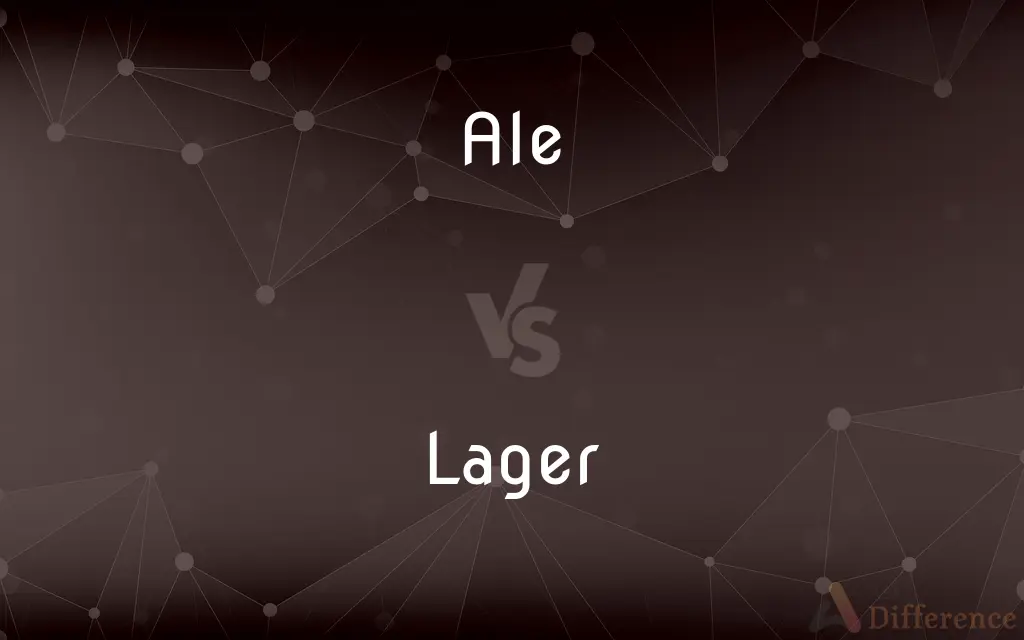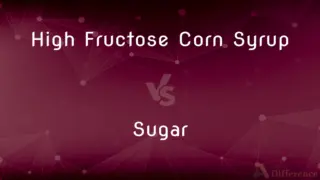Ale vs. Lager — What's the Difference?
By Tayyaba Rehman — Published on February 13, 2024
Ale and Lager are beer types differentiated by yeast and fermentation. Ale uses top-fermenting yeast at warmer temperatures, resulting in a robust flavor, while Lager employs bottom-fermenting yeast at cooler temperatures for a cleaner taste.

Difference Between Ale and Lager
Table of Contents
ADVERTISEMENT
Key Differences
Ale is a type of beer crafted with top-fermenting yeast, Saccharomyces cerevisiae, which ferments at warmer temperatures (60-75°F or 15-24°C). This process imparts a rich and complex flavor profile to Ales, characterized by fruity, spicy, and sometimes bitter notes. The brewing time is relatively short, often a few weeks, contributing to a quicker turnaround.
Lager, on the other hand, utilizes bottom-fermenting yeast, Saccharomyces pastorianus, and ferments at cooler temperatures (45-55°F or 7-13°C). Lagering involves a more extended conditioning period, often several weeks to months, resulting in a smoother, cleaner taste with fewer fruity esters. Lagers often have a crisp finish, and their brewing process is associated with cold storage or "lagering."
Comparison Chart
Yeast Type
Top-fermenting yeast (S. cerevisiae)
Bottom-fermenting yeast (S. pastorianus)
Fermentation Temperature
Warmer temperatures (60-75°F or 15-24°C)
Cooler temperatures (45-55°F or 7-13°C)
Flavor Profile
Robust, fruity, and spicy with varied bitterness
Clean, crisp, and smooth with fewer fruity esters
ADVERTISEMENT
Fermentation Time
Shorter brewing time, usually a few weeks
Longer conditioning period, weeks to months
Examples
Pale Ale, Stout, IPA
Pilsner, Helles, Bock
Compare with Definitions
Ale
Brewed with top-fermenting yeast, Ales offer a diverse flavor range, from fruity to bitter.
Pale Ales often showcase the hoppy bitterness characteristic of ales.
Lager
The bottom-fermenting yeast in lagers results in a cleaner taste and fewer complex aromas.
The crispness of lagers makes them a popular choice for those favoring a straightforward beer experience.
Ale
Known for its robust and complex flavor profile, featuring fruity and spicy notes.
Belgian Dubbels are a type of ale celebrated for their rich and malty complexity.
Lager
Characterized by a milder flavor profile, with fewer fruity esters than ales.
Munich Helles is a lager style known for its balanced maltiness and smooth finish.
Ale
Fermented at warmer temperatures, resulting in a quicker brewing process.
The ale-making process typically takes a few weeks, producing ales in a relatively short time.
Lager
Fermented at cooler temperatures, contributing to a longer and smoother brewing process.
Lagers undergo a lagering phase at near-freezing temperatures, enhancing their clarity and taste.
Ale
Varied styles, including stouts, IPAs, and porters, fall under the broader category of ales.
India Pale Ales (IPAs) are a popular ale style known for their hop-forward and bitter characteristics.
Lager
Brewed with bottom-fermenting yeast, Lagers offer a clean and crisp taste.
Pilsners, a classic lager style, are recognized for their refreshing and light profile.
Ale
A usually full-bodied beer that has been fermented at a relatively warm temperature.
Lager
Common styles include Bocks, Märzens, and Dunkels, showcasing the versatility of lagers.
Bocks, such as Doppelbocks, are lagers known for their malty sweetness and higher alcohol content.
Ale
A serving of this beer.
Lager
A beer of German origin that is fermented for a relatively long time at a low temperature. Also called lager beer.
Ale
(dated) A beer made without hops.
Lager
A type of beer, brewed using a bottom-fermenting yeast.
Ale
A beer produced by so-called warm fermentation and not pressurized.
Lager
To store (lager beer) at a low temperature for maturing and clarification.
Ale
A festival in English country places, so called from the liquor drunk.
Lager
Alternative spelling of laager
Ale
An intoxicating liquor made from an infusion of malt by fermentation and the addition of a bitter, usually hops.
Lager
Lager beer.
Ale
A festival in English country places, so called from the liquor drunk.
Lager
A camp defended by a circular formation of wagons
Ale
A general name for beer made with a top fermenting yeast; in some of the United States an ale is (by law) a brew of more than 4% alcohol by volume
Lager
A general term for beer made with bottom fermenting yeast (usually by decoction mashing); originally it was brewed in March or April and matured until September
Ale
Top-fermenting yeast contributes to ales' distinctive esters and aromatic qualities.
The fruity aroma in many ales is a result of the yeast interacting with the malt.
Common Curiosities
How does lagering contribute to the taste of lagers?
Lagering, or cold storage, imparts a smoother and cleaner taste to lagers during an extended conditioning period.
Why are lagers often associated with a crisp finish?
The bottom-fermenting yeast and cooler fermentation temperatures contribute to the clean and crisp taste of lagers.
Do ales have a higher variety of beer styles than lagers?
Yes, ales encompass a broad range of styles, including stouts, IPAs, porters, and Belgian ales.
Can ales be brewed and ready to drink faster than lagers?
Yes, ales generally have a shorter brewing time due to the warmer fermentation temperatures.
What gives ales their diverse flavor range?
Ales derive their varied flavors from top-fermenting yeast, creating fruity, spicy, and bitter notes.
Are lagers always lighter in color than ales?
While many lagers are lighter, styles like Dunkels and Bocks can have darker hues.
Can lagers have fruity flavors like ales?
While lagers generally have fewer fruity esters, some styles may exhibit subtle fruitiness.
Do ales typically have a stronger and more pronounced aroma?
Yes, the top-fermenting yeast in ales contributes to distinctive esters and aromatic qualities.
Can ales have high alcohol content?
Yes, styles like Barleywines and Belgian Tripels are ales known for their higher alcohol content and complex flavors.
Are there ales with low bitterness?
Yes, styles like Brown Ales or Mild Ales often have lower bitterness compared to hop-forward styles like IPAs.
Can ales be brewed with various types of yeast?
Yes, ales can utilize different yeast strains, contributing to the diverse array of flavors within the ale category.
Is lagering a critical step in the brewing process?
Yes, lagering is crucial for lagers as it enhances clarity, smoothness, and allows flavors to meld during cold conditioning.
Do ales pair well with spicy foods?
Yes, the robust and varied flavors of ales, including the spice notes, often complement spicy dishes.
Why are pilsners considered a classic lager style?
Pilsners are known for their refreshing and light profile, making them a quintessential example of the lager category.
Are there dark lagers similar to dark ales?
Yes, styles like Dunkels and Schwarzbiers are dark lagers known for their malt-forward and roasty characteristics.
Share Your Discovery

Previous Comparison
Carpet Flooring vs. Laminate Flooring
Next Comparison
High Fructose Corn Syrup vs. SugarAuthor Spotlight
Written by
Tayyaba RehmanTayyaba Rehman is a distinguished writer, currently serving as a primary contributor to askdifference.com. As a researcher in semantics and etymology, Tayyaba's passion for the complexity of languages and their distinctions has found a perfect home on the platform. Tayyaba delves into the intricacies of language, distinguishing between commonly confused words and phrases, thereby providing clarity for readers worldwide.
















































